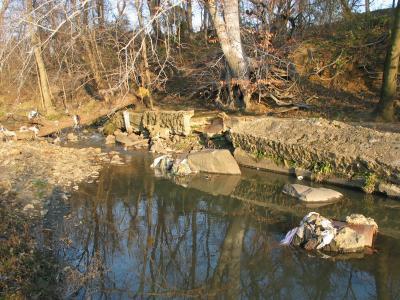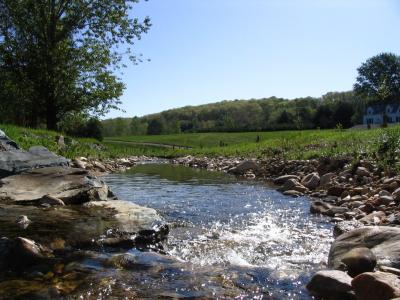Most people think of city landscapes as simpler, diminished versions of the wild forests and free-flowing streams found in remote places. A series of studies in the journal Biogeochemistry says the opposite is true. Urban landscapes are more complex than they seem, and from coast to coast these ecosystems can work in surprisingly similar ways, regardless of local conditions. And they have the potential to change quickly – for better or worse – depending on how people manage them.
In 14 studies, scientists from across the U.S. examined the impacts of human actions on the geology, chemistry and biology of urban ecosystems. The studies were carried out in a broad range of climates from Boston and Baltimore to San Juan, Puerto Rico;Tucson, Arizona; and Southern California, including sites in the National Science Foundation's Long Term Ecological Research (LTER) network.

Eroding stream banks and aging sewer lines contribute to evolving water pollution problems in cities. In this photo from Baltimore, Maryland, a sewage pipe that was originally placed in a stream bed developed leaks, and is now surrounded by a concrete casing.
(Photo Credit: Tamara Newcomer Johnson, University of Maryland)
The issue was edited by University of Maryland geologist Sujay Kaushal and University of New Hampshire ecologists William McDowell and Wilfred Wollheim. "Urban ecosystems change relatively quickly in response to human activities," says Kaushal. "These changes can result in rapid losses of ecosystem functions, like flood protection and pollution filtration, or they can result in progress toward ecological health and productivity. The difference depends in large part on how they are managed."
In an overview article, Kaushal, McDowell and Wollheim point out some key factors that affect the evolution of urban ecosystems. For example, the streams, lakes and land surfaces that make up cities' watersheds show consistent patterns of change over time:
- They are becoming saltier, partly due to road salt used for de-icing, and partly because the salt that people eat ends up in urban streams. Excess salt in the human diet is excreted in human waste, and captured by sewer systems. Crumbling sewage pipes leak this chloride-laden waste into groundwater, where it eventually mingles with surface water, say the authors of the overview paper. The researchers propose that one way to track the spread of urbanization is by looking at the chloride content of cities' freshwater rivers and streams.
- They carry the chemical signature of dissolving concrete, a major building material in urban areas since the mid-20th century. Most concrete contains cement made of powdered limestone, which weathers easily when exposed to acid rain or chemicals. The authors say many cities now have their own human-made geology: concrete surfaces that mimic a type of limestone called karst. This "urban karst" is constantly breaking down into its constituent elements, including calcium and carbonate minerals, which flow into urban streams and affect their pH content, and therefore their ability to sustain aquatic life.
- Urban ecosystems develop "hot spots," like road crossings where automobile exhaust, litter, de-icing salt and other human-made substances can sharply alter downstream water quality. They also experience "hot moments," such as heavy rainstorms that wash large pulses of organic matter and manufactured chemicals into streams, or cause sewage overflows. These hot moments can suddenly change water chemistry in ways that shock natural systems.
- The networks that supply cities with water evolve and expand over time, including not just surface waters, but also storm drains, leaking water and sewer pipes, roofs and gutters, groundwater, and waste water that humans bring into the area from other watersheds. The boundaries between nearby cities' watersheds are blurring, making it hard to define, study and manage them.
"There is a lot of good urban restoration work underway," says McDowell, "but often it only has a short-term effect, because urban watersheds follow their own evolutionary paths. For example, utility managers may build a stormwater retention pond to capture polluted runoff, such as excess nitrogen from urban runoff. And it may work very well for a few years. But then it fills in with sediment, and becomes a wetland, and it's no longer working the way the engineers designed it to work."

This stream restoration project in Baltimore, Maryland is in an early stage of evolution towards sustainability. A concrete channel that enclosed the stream has been removed, and native tree seedlings have been planted along its banks.
(Photo Credit: Tamara Newcomer Johnson, University of Maryland)
"We hope scientists, managers and citizens will work together to make decisions that allow for what we call 'urban evolution,' – that is, changes in the ecology of cities over time, " says Kaushal. "If we do that, we can find effective ways to understand and manage the trajectory of urban ecosystems, from decline towards sustainability."
"This synthesis brings the power of evolutionary biology to understanding ecosystem processes in urban environments, some of the most rapidly changing habitats globally," says Saran Twombly, NSF's LTER program director. "Merging evolutionary biology with ecosystem sciences is an exciting frontier for long-term ecological research, beginning with this issue on biogeochemical cycles."

In this stream restoration project in Baltimore County, Maryland, a suburban stream and its floodplain have been reconnected to help control erosion and protect nearby bridges and sewer lines from floods.
(Photo Credit: Paul Mayer, US EPA)
Source: University of Maryland